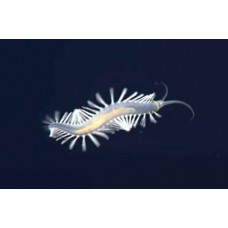The name comes from the ancient Greek βίος "life" + Latin lumen "light" + Latin escendere "to shine". In more advanced organisms, light is produced in special light organs (e.g. in the photophores of fish), in unicellular and primitive multicellular eukaryotes - in special organoids, and in bacteria - in the cytoplasm.
Bioluminescence is the ability of living organisms to emit light. Luminescence is based on the enzymatic oxidation of luciferins during the life activity of organisms. Three types of luminescence are observed - intracellular, extracellular and bacterial, caused by symbiotic luminescent bacteria. With the exception of some species of molluscs, fungi and bacteria, all luminescent organisms live in the sea. Among fish, only marine fish are luminescent. Luminescence is particularly common in deep-sea fish.
Bioluminescence is a chemiluminescent process and is caused by the enzymatic oxidation of substrates - luciferins - catalysed by luciferase enzymes, whereby the oxidation product is formed in an excited electronic state and the transition of the oxidation product from the excited state to the ground state is accompanied by the emission of a photon in the visible spectral region.
In the bioluminescent systems of marine organisms of a wide range of taxa, from coelenterates to crustaceans, luciferins, whose structure is based on the imidazopyrazine core, are widely used. At least five forms of imidazopyrazine act as luciferins: wargulin of crustaceans (ostracoda); celenterazine of cnidarians and bristle worms; celenterazine disulfate, which is the luciferin of the squid lightfish Watasenia scintillans; celenterazine peroxide, which acts as a functional group of the ecvorin and obelin proteins of the obelius dehydroform in the squid photoprotein simplektin.
The New Zealand gastropod mollusc Latia neritoides, which produces a luminescent green mucus, is remarkable in that it is currently (2009) the only known species of freshwater mollusc capable of bioluminescence. Luciferin is the formate of an enol form of terpene aldehyde, which is oxidised to dihydro-β-ionone, formic acid and carbon dioxide. Several analogues containing an enol formate and an enol acetate group were synthesised and it was shown that the trimethylcyclohexane ring of luciferin is an essential structural fragment for luminescence upon oxidation. Luciferase (Latia-luciferin-2-monooxygenase (demethylating), CF 1.14.99.21) is a protein with a molecular weight of ~170 KDa, and a "purple protein" with a molecular weight of ~40 KDa is also involved in the reaction (Shimom, p. 187). The role of the "purple protein" is still unclear, it participates in the reaction in catalytic rather than stoichiometric amounts and can be replaced by ascorbate + NADH, it is thought to be involved in the regeneration of one of the substrates of the luciferin-luciferase system. It was originally suggested that the "purple protein" might be an emitter in the Latia luminescence process[25], but this has not been confirmed.
Bioluminescence has the following biological functions: attraction of prey or mates communication warning or threat deterrence or distraction camouflage against natural light sources In many cases, the function of bioluminescence in the life of individual luminous organisms is not fully understood, or not studied at all.
Bioluminescence
Tags: Bioluminescence



